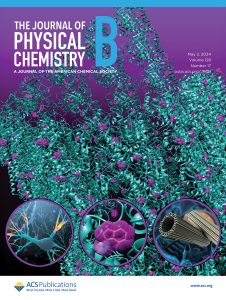Supported by The Guy Foundation, the Kurian Lab and coworkers publish their research on quantum biology in The Journal of Physical Chemistry, with selection as Editors’ Choice by Science magazine.
The Guy Foundation is pleased that groundbreaking quantum biology results from one of its funded research studies have been published in The Journal of Physical Chemistry, with selections as a feature cover by The JPC and as Editors’ Choice by Science magazine. The project was led by Dr Philip Kurian, Principal Investigator and Founding Director of the Quantum Biology Laboratory (QBL) at Howard University in Washington, DC, who with coworkers in Mexico, Italy, and Switzerland investigated whether superradiant states can be supported in large protein aggregates characteristic of living systems. Philip presented this research as part of The Guy Foundation 2023 Spring Series, and his presentation is available to view here.
Superradiance is a phenomenon that occurs when light-sensitive atoms or molecules interact collectively with a common light source. This means that instead of the light source exciting a single molecule at a time, it causes a communal excitation of a network of molecules at once. In the limit of ultraweak excitation or a single photon, a fundamentally quantum effect can still arise due to that photon being coherently shared across the network, which enhances the fluorescence decay rate. To probe this phenomenon, the Kurian Lab and coworkers examined the behaviour of this photoexcited network, including the enhancement of properties such as the fluorescence quantum yield. Contrary to the conventional expectation that quantum effects cannot survive in large objects with warm environments, their work represents the world-first demonstration of micron-scale, collective quantum optical behavior in a solvated protein aggregate at room temperature.
This important study by Philip Kurian and collaborators, funded by The Guy Foundation, demonstrates that networks of strongly fluorescent amino acids, known as tryptophans, display robust cooperative effects suggesting the formation of superradiant states, in a thermal environment. Furthermore, due to their symmetry, the specific architectures of these tryptophan networks, which are found in transmembrane proteins, cytoskeletal filaments, sub-neuronal elements, photoreceptor complexes, virion capsids, and other cellular structures, play an essential role in stimulating this superradiance. This conclusion is supported by both rigorous theoretical modelling of large, realistic quantum networks in neurons and centrioles, as well as precise experimental confirmation of quantum yield enhancements in microtubules.
Professor Geoffrey Guy, Founder and Chairman of The Guy Foundation, commented: “The Foundation has a keen interest in the interaction of light with biological systems, which stems from our history of research into light-reactive molecules known as chromophores. It is gratifying to see both theoretical and experimental evidence that quantum effects play a novel role in biology, and that chromophores are pivotal to these effects. Congratulations to Philip and his co-authors on these exciting results and the success of their publication”.
In 2023, Philip also received a $1M grant from the Alfred P. Sloan Foundation Matter-to-Life programme to investigate self-organization and agency due to light-matter interactions in the syncytial slime mold, Physarum polycephalum. The project is a collaboration with Professor Michael Levin, Director of the Tufts Center for Regenerative and Developmental Biology and himself a Guy Foundation research collaborator.
Philip commented: “The QBL is very grateful to The Guy Foundation for their substantial investment in our lab over the last few years, as well as for the novel discussions they initiate through their online seminars, which have helped us to form strong research connections and think in broad-minded, innovative ways. With the QBL having completed its initial Guy Foundation project, we were able to build on the conversations and contacts we have made through the Foundation, with the body of work we have generated, to form a strong case for support – resulting in the Sloan grant. This will take us some way further toward achieving our long-term vision. As Schrödinger, Aristotle, and many others in and outside the West have asked, What is Life? Exploring such old questions from novel vantage points is enhanced by the Foundation’s growing network of scientists, who are generating knowledge at the intersections of biology, chemistry, and physics. We greatly enjoy being part of this dynamic group and look forward to seeing deepened collaborations emerge over time”.
About the Guy Foundation
The Guy Foundation is a UK-based charitable foundation established in 2018 to facilitate thinking and research on the role of quantum mechanics and thermodynamics in living systems, with the ultimate goal of using this understanding to advance healthcare. We curate, lead and fund an inter-disciplinary research collaboration and have published a number of scientific papers. We support the quantum biology community by convening online symposia on quantum biology and bioenergetics and we host an active network of over 200 scientists and institutions across the globe. You can find more details on our website, including talks, publications and who we are: www.theguyfoundation.org.
Contact us: info@theguyfoundation.org
About the Quantum Biology Laboratory (QBL)
With a transformative vision that extends from the subatomic to the clinical scale, the QBL studies how collective behaviours in living matter can be manifested, controlled, and exploited for the development of advanced tools, diagnostics, and therapies to address neurodegenerative, oncological, immunological, and oxidative metabolic disorders. Investigators in the Quantum Biology Laboratory use techniques from quantum optics, quantum information, theoretical physics, spectroscopy, structural/molecular biology, and high-performance computing to solve an array of problems relevant to quantum effects in living processes. For more information, visit www.quantumbiolab.com.


